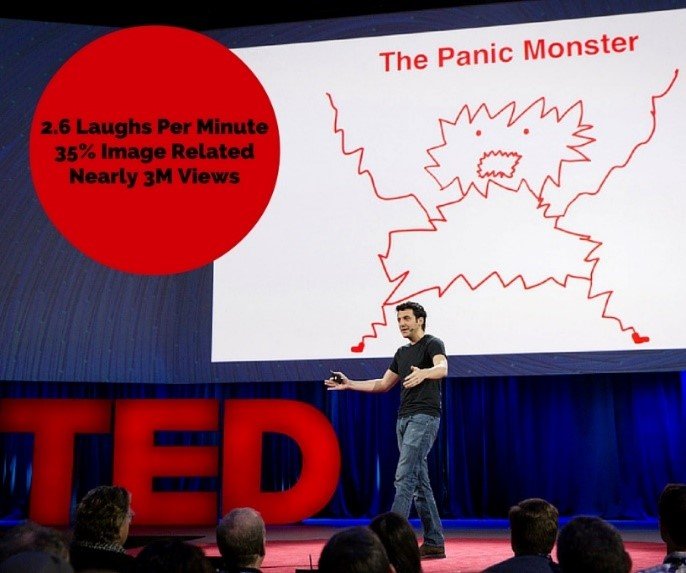Guest Post: FunnyBizz Founder David Nihill on the Funniest TED Talks

As so many of us do, David Nihill used to have serious stage fright — the sweats, the shakes… we’re all familiar with the side effects of public speaking anxiety. But Nihill knew it was time to overcome that fear. Inspired by Malcolm Gladwell’s 10,000 hour rule, he considered who spends the most time on stage, in the most challenging conditions: standup comedians. So Nihill made a bold choice: he spent a full year performing standup comedy in order to overcome stage fright.
Along the way, Nihill discovered the standup comedy techniques that helped him overcome his stage fright, and learned how business leaders can incorporate those techniques into their own engagements to keep their audiences engaged, and ensure their messages rise above the noise. He dives into these findings in his book, Do You Talk Funny?
But, to give you a preview, we’re honored to share Nihill’s article on how TED speakers use humor, adapted from his book. He analyzed the most-viewed TED Talks, comparing their laugh-per-minute rating to some of the funniest films of all time.
Forget The Hangover — these TED Talks Rake in the Laughs
By David Nihill, adapted from his book, Do You Talk Funny?
As business, entertainment, and comedy become ever more intertwined, many top business speakers are turning to humor as the ultimate tool for keeping audiences’ attention and being memorable amid the ringtones and vibrations of modern life.
Wait but Why author, Tim Urban, is one of those speakers.
He knows procrastination doesn’t make sense, but like many of us he’s never been able to shake his habit of waiting until the last minute to get things done. This year he stole the show at TED’s mainstage event in Vancouver with, “Inside the Mind of a Master Procrastinator,” a talk even TED themselves describe as hilarious.

A few years ago, a London-based video streaming service called LoveFilm developed a system to identify the funniest movies of all time by tracking laughs per minute. It’s important to note this does not track how big the laughs were, but only their frequency. If we apply the same system to Tim Urban’s talk, recording how frequently the audience laughed as a group, we find he gets 2.6 laughs per minute, enough to rival an up-and-coming comedian.
For comparison, the laugh-per-minute (LPM) rates of the funniest films of all time:

According to the laughs-per-minute rating, Urban is funnier than The Hangover — and, needless to say, a lot more informative! His use of humor, his passion and his insightful, inspirational message combine to make up the ingredients of something really powerful. Is it any wonder we all love it?
And Urban is not alone: every one of the top ten most-viewed TED talks uses humor.
The seven funniest might just be enough to make you think twice before looking to a comedy movie for your regular dose of LOLs:

Mary Roach’s talk about orgasm generated more laughs per minute than the funniest movie ever made. Happiness researcher Shawn Achor’s “The Happy Secret to Better Work,” generates more laughs per minute than all but one of the world’s funniest movies. “This Is Broken” by Seth Godin generated nearly three times the frequency of laughs as Monty Python’s classic Life of Brian.
Yes, these numbers are loose; no, they don’t factor in an allowance for the varied running times, and they don’t allow for the level of laughter generated, but the underlying takeaway is clear: Top TED speakers are making audiences laugh just as much as top box office comedies.
The good news for you, if you want to add laughter to your own engagements, is that many of the laughs in these talks come from the use of funny images (58% in Seth Godin’s talk and 35% in Tim Urban’s). You may not consider yourself naturally funny but you’re certainly capable of finding and inserting images that are. These numbers suggest modern day audiences may even expect you to.
David Nihill is the Founder of FunnyBizz, a community, writer platform, and conference series, where business meets humor to abolish boring content. His work has been featured in Inc., Lifehacker, The Huffington Post, Fast Company and Forbes. A graduate of the UCD Michael Smurfit Graduate Business School he wears a tie, but only to bungee jump.
You can get 80 tips to become a funnier public speaker free here.